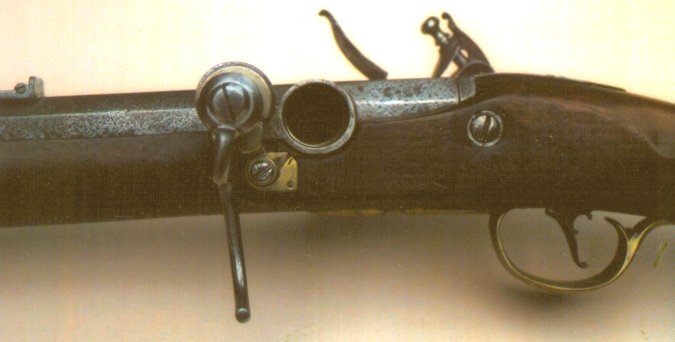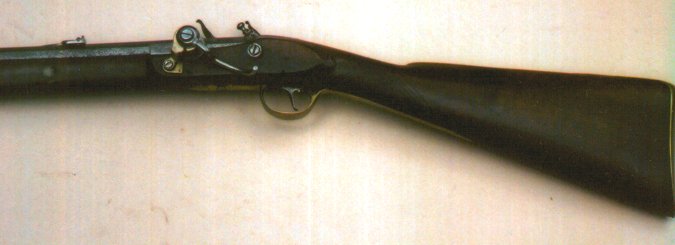

EXTREMELY RARE "MANTON" SIGNED BREECH LOADING FLINTLOCK RIFLE, ca. 1810: In overall fine original flintlock condition. The key fastened, octagonal, deeply rifled, .70 caliber, 28 1/2", iron barrel with an integral side-mounted threaded breech section, which accesses the powder chamber. The top of the breech with a "*"/R. W" maker's mark and a "PRO" "VED:" (Birmingham, ca. 1800) proof mark. The maker's mark is that of Richard Wilson 1 (1772-1805), who worked in London, UK (please see H. L. Blackmore's: Gunmakers of London 1350-1850", pg. 203). Walnut fullstock of quasi-military design with a robust comb-less butt section and a heavy forestock: nicely checkered wrist. Fitted with its original, martial type, brass mounts. Brown Bess type butt-plate with a stepped finial, three (3) baluster ramrod pipes, a pin-fastened nose-cap and an acorn finial type trigger-guard with a pointed rear. The side of the breech fitted with its original iron screw-lever-- which unthreads to expose the breech, for loading: the Paktong bridle is screw fastened to a rectangular brass base. The system is reminiscent of a side-mounted "Ferguson" and is very similar to the design of breech-loading rifle made by James Wilkes (please see H. L. Blackmore's: British Military Firearms", pg. 145). Fine quality lock with an engraved French type hammer, a sliding rear safety (defective), scroll engraved borders, a bridled waterproof powder-pan and a roller on the frizzen spring. Signed under the powder pan with a "MANTON" signature in engraved block characters, for. J. Manton of London, UK (please see H. L. Blackmore, pg. 137-138). In overall fine original flintlock condition. The barrel with smooth surfaces, sharp contours/markings and its original platinum touch-hole liner: fine bore. Some isolated patches of discoloration, moderate pitting overall and light wear. Retains its original, iron, "buck-horn", rear sight. The lock with matching smooth surfaces, 15% original polish, scattered pitting, some wear to the signature and in mechanically functional order: associated top-jaw. Very fine stock with much of its original finish, some light handling marks, a tight hairline at the fore-end tip and very good checkering at the wrist with, some light wear. The hardware with a lightly toned mustard patina and evidence of a light cleaning. A very rare and well made Breech-Loading Flintlock Rifle by a member of the esteemed "Manton" gunmaking Family. A unique opportunity to acquire an authentic English Military type Breech-loading Flintlock OFFICER"S Rifle. ***Quite possibly a privately commissioned, experimental-type, officer's weapon: as suggested by its overall appearance and large caliber. Retains its original iron cleaning rod. Overall length, 44 1/2".
http://www.ambroseantiques.com
Last edited by a moderator:





